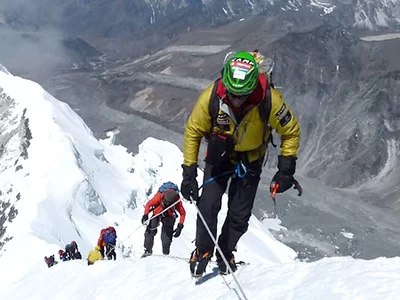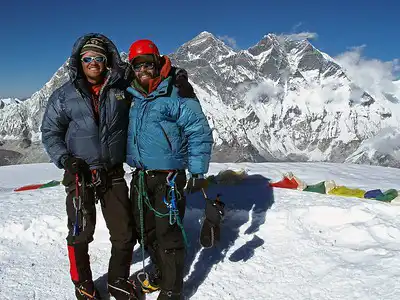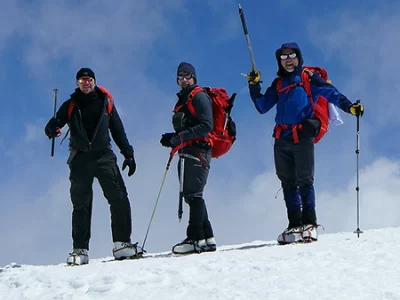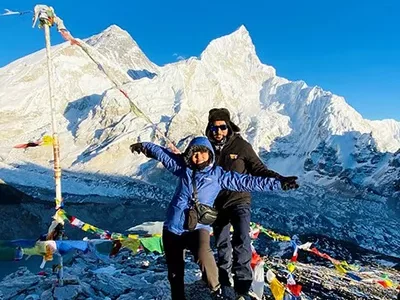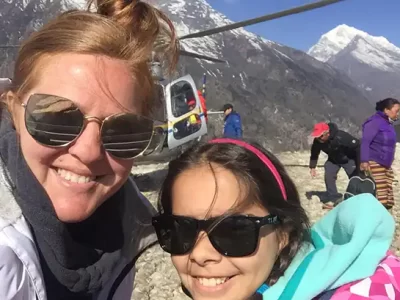Island Peak, also known as Imja Tse, is a famous trekking peak in Nepal’s Everest region. It is very accessible with its routes and is 6189 meters high, which attracts climbers of all levels for incredible views. The best time to climb Island Peak is crucial for ensuring a safe and enjoyable ascent, with most climbers opting for favorable weather conditions in spring and autumn.
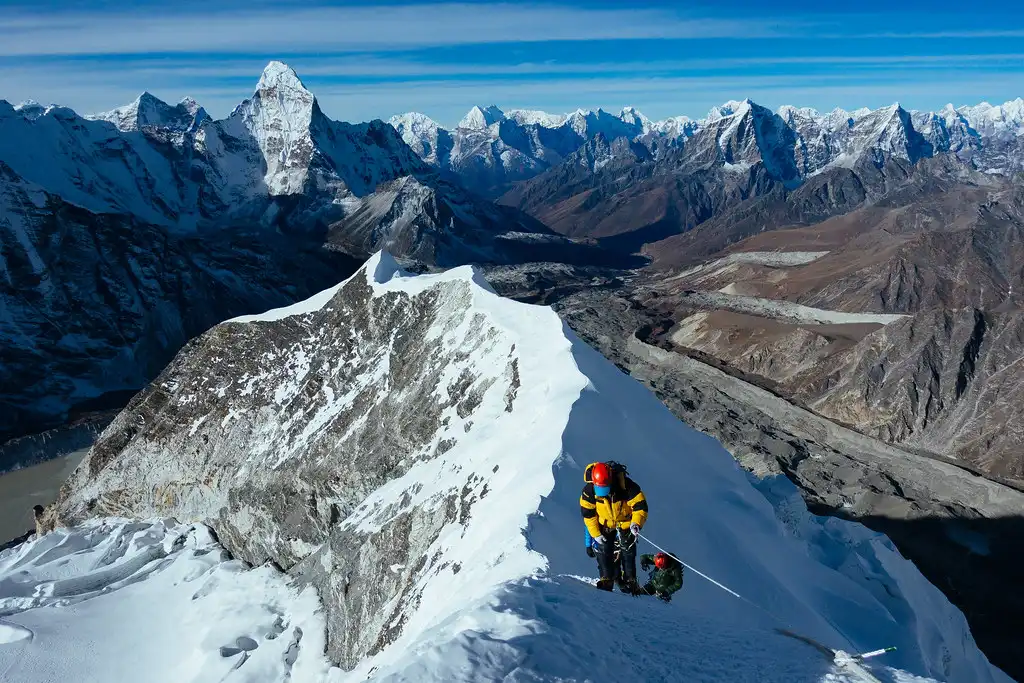
These seasons offer the ideal balance of clear skies, moderate temperatures, and manageable trekking conditions. Nestled in the heart of the Khumbu region, Island Peak is a stepping stone for mountaineers aspiring to climb higher Himalayan peaks.
The mountain is part of many trekking itineraries, including the famous Everest Base Camp trek, adding to its popularity among adventure enthusiasts worldwide.
Critical Facts About Island Peak:
- Elevation: Island Peak is 6,189 meters (20,305 feet) above sea level, making it challenging but attainable for trekkers with basic mountaineering skills.
- Location: The peak lies in the Solu-Khumbu region of Nepal, near the villages of Chhukung and Dingboche. It is in the Sagarmatha National Park, home to some of the world’s highest peaks, including Mount Everest.
- Popularity Among Climbers: Novice and seasoned trekkers prefer Island Peak. It offers a thrilling climbing experience without requiring extensive technical skills, making it an ideal “first Himalayan summit” for many.
- Importance as a Trekking Peak: Island Peak is not just a standalone climb. It’s often part of a broader trekking circuit, such as the Everest Base Camp trek, offering a blend of high-altitude and moderate mountaineering. Reaching the summit provides climbers with breathtaking views of Lhotse, Nuptse, and even the distant Makalu.
Island Peak Climbing with EBC Trek
Ama Dablam Expedition
Mera Peak Climbing
Best Time to Climb Island Peak: Ideal Seasons for Climbing
Climbing Island Peak requires careful planning, especially when considering the best time for optimal conditions. The best time to climb Island Peak is mainly in autumn and spring. Autumn (September to November) stands out as one of the most popular periods due to favorable weather and ideal trekking conditions.
Autumn (September to November)
Many climbers consider autumn to be the ideal time to ascend Island Peak. This season offers climbers stable weather, making the ascent safer and more enjoyable. Here’s why autumn is the top choice for many:
- Stable Weather Conditions: Autumn’s post-monsoon weather is typically dry and stable, minimizing the risk of unpredictable storms or heavy snowfall. Clear skies dominate this period, allowing climbers to enjoy stunning views of the surrounding peaks.
- Excellent Visibility: Autumn’s clear skies provide superb visibility, giving climbers breathtaking panoramic views of Mount Everest, Lhotse, and Ama Dablam. The trek to Island Peak offers a challenging climbing experience and spectacular scenery.
- Comfortable Temperatures: During the autumn months, daytime temperatures at lower altitudes hover around ten °C to 15°C (50°F to 59°F). As you ascend, temperatures at higher altitudes drop, especially at night, reaching around -10°C to -15°C (14°F to 5°F) at the summit. However, the crisp air and cool breeze make climbing much more bearable than the harsher winter months.
- Ideal Trekking Conditions: The trails leading to Island Peak are in excellent condition after the monsoon rains, making trailing easier. Additionally, there are fewer chances of encountering muddy or slippery paths.
Spring (March to May)
Spring is another Best Time to Climb Island Peak, offering several unique benefits. Here’s why many climbers choose this time:
- Blooming Landscape: Spring in the Everest region brings nature to life. The trails are lined with colorful rhododendrons and other alpine flora, creating a breathtaking backdrop for your climb. This seasonal beauty adds an extra element to the trekking experience, making the adventure more enjoyable as you ascend through the Khumbu Valley.
- Favorable Temperatures: Spring offers moderate temperatures that make the climb comfortable. At lower altitudes, daytime temperatures range from 15°C to 20°C (59°F to 68°F). As you ascend higher, it cools down, with summit temperatures dropping to around -10°C to -15°C (14°F to 5°F). While still cold at the peak, these temperatures are more manageable than in winter, especially with proper gear.
- Lively Atmosphere: Spring is a busy season for trekking and climbing in the Everest region. The trails are more crowded and filled with climbers and trekkers aiming to scale Island Peak or other nearby peaks like Everest and Lhotse. Climbers often share tips and stories along the trail, creating a strong sense of camaraderie. However, this also means you should prepare for busier tea houses and more trail traffic.
- Clearer Weather with Slight Risks: The occasional pre-monsoon shower in May can occur, while spring weather is generally stable, especially in March and April. However, these are usually light and don’t interfere significantly with climbing plans.
Winter (December to February)
Winter in the Everest region brings intense cold, heavy snowfall, and more technical challenges. Here’s why winter climbing is challenging:
- Colder Temperatures: During winter, temperatures at Island Peak can plummet to extreme lows. Daytime temperatures at lower altitudes hover between -5°C to 5°C (23°F to 41°F). Temperatures at the summit of Island Peak can reach as low as -20°C to -30°C in autumn, even though the season is generally mild. This extreme cold makes it difficult to maintain warmth and can increase the risk of frostbite, especially if not equipped with proper cold-weather gear.
- Heavy Snowfall: Winter also brings frequent and heavy snowfall, which can accumulate on the trails and the peak itself. The technical difficulty of the climb increases because of this factor. Fresh snow can cover crevasses, making navigation more dangerous and requiring climbers to have advanced mountaineering skills and experience with ice climbing.
- Technical Difficulties: The combination of icy paths, high winds, and deep snow makes the ascent more technically challenging during winter. You must be proficient in using crampons, ice axes, and ropes to tackle the icy slopes. Winter climbing techniques can be particularly daunting for those with less experience.
- Not Ideal for Most Climbers: Winter is generally not recommended for most climbers due to these challenges. Only seasoned mountaineers with experience in extreme cold and technical conditions should attempt Island Peak during this time. The cold and high-altitude conditions can also limit the availability of guides and support teams, making the climb even more difficult.
Monsoon (June to August)
Monsoon weather brings several challenges for climbers, affecting both the physical conditions of the trail and the overall climbing experience. Here’s what to expect:
- Heavy Rainfall: During the monsoon season, Island Peak and the surrounding region experience frequent heavy rain. The continuous downpours can make trails slippery, increasing the chances of falls and injuries. Rain can significantly hinder a climb on Island Peak, as wet gear can make the ascent more challenging and uncomfortable.
- Cloudy Skies and Poor Visibility: The monsoon months are characterized by dense cloud cover, obstructing the stunning views that make Island Peak so appealing. Without clear skies, climbers miss the breathtaking scenery of nearby peaks like Lhotse and Mount Everest. Poor visibility also complicates navigation, especially in higher altitudes.
- Increased Risk of Landslides: Heavy rain and steep terrain make landslides a common hazard during the monsoon season. Landslides can block trails or create dangerous situations, making the ascent more unpredictable and unsafe. Due to the challenging conditions, many guides and agencies recommend avoiding Island Peak during this period.
- Slippery Trails: The persistent rain turns the already challenging trekking paths into muddy, slippery terrain. The added challenge increases the climb’s difficulty, requiring more caution and effort to ensure safe movement. For climbers not experienced with wet, slippery conditions, the monsoon season can make the climb far more demanding than other times of the year.
Lobuche Peak Climbing
Everest Base Camp Trek
Everest Base Camp Trek with Helicopter Return
Best Time to Climb Island Peak: Weather Conditions and Temperature Insights
Choosing the best time to climb Island Peak is influenced mainly by weather conditions and temperatures. Each season brings its own set of challenges and advantages. This comprehensive breakdown of typical weather patterns, average temperatures, and their impacts on the technical aspects of the climb will help climbers make informed decisions about when to schedule their expedition.
Typical Weather Patterns
- Spring (March to May): Spring offers clear skies and progressively warming temperatures. This season marks a prime time to climb Island Peak due to stable weather, making it a popular choice for climbers.
- Autumn (September to November): Like spring, autumn provides stable weather with minimal precipitation and clear skies. Due to these favorable conditions, climbing is considered the peak season.
- Winter (December to February): Frigid temperatures and heavy snowfall during winter increase the technical challenges and risks of the climb.
- Monsoon (June to August): The monsoon season is characterized by heavy rains, cloud cover, and a high risk of landslides, making it the least favorable time to climb Island Peak.
Average Temperatures
Base Camp:
- Spring: Ranges from -1°C to 5°C (30°F to 41°F)
- Autumn: Stays around -1°C to 5°C (30°F to 41°F)
- Winter: Drops to -10°C to -20°C (14°F to -4°F)
- Monsoon: Sits between 5°C to 15°C (41°F to 59°F)
Summit:
- Spring: Can vary from -15°C to -20°C (5°F to -4°F)
- Autumn: Also ranges from -15°C to -20°C (5°F to -4°F)
- Winter: Plunges to -30°C to -35°C (-22°F to -31°F)
- Monsoon: Falls between -10°C to -15°C (14°F to 5°F)
Impact of Weather on Climbing Difficulty
Weather conditions significantly influence the technical difficulty of climbing Island Peak. Here’s how:
- Spring and Autumn: These seasons provide the best time to climb Island Peak due to moderate temperatures and clear weather, which minimize technical climbing difficulties. The stable conditions allow climbers to focus on the ascent without worrying about severe weather changes.
- Winter: The extreme cold and snow accumulation increase the technical difficulty of the climb. Routes become icier, requiring more advanced gear and skills. The risk of avalanches and frostbite also rises, demanding excellent preparation and caution.
- Monsoon: Slippery trails, visibility issues, and unpredictable weather patterns add to the climb’s complexity. The risk of landslides can alter routes overnight, requiring constant vigilance and flexibility in plans.
Best Time to Climb Island Peak: Identifying the Optimal Months
Choosing the best time to climb Island Peak requires careful consideration of the best months, significantly affecting the overall climbing experience. October and April are the most favorable times due to ideal weather conditions, excellent visibility, and an enhanced trekking experience. This detailed analysis will help climbers decide when to plan their adventure, providing insights into early versus late spring and autumn climbs.
Best Months for Climbing Island Peak
- October: Often considered the pinnacle of the autumn climbing season, October offers clear, stable weather with minimal precipitation. Climbers highly favor this month’s crisp air and clear skies, which provide spectacular views of the surrounding Himalayan peaks. Temperatures are cold but manageable, making it a comfortable time to ascend to higher altitudes.
- April: As the prime month of the spring season, April provides similar benefits to October, with the added vibrancy of blooming flora along the trekking routes. The weather remains stable with very little rainfall, ensuring solid ground and clear paths for climbers.
Comparing Early vs. Late Season Climbs
Early Spring (March to April) vs. Late Spring (May):
- Early Spring: March and April are preferable for those looking to enjoy the rejuvenation of the landscape without the entire influx of monsoon moisture that May sometimes brings. The temperatures are on the rise, which can make for a more comfortable climb.
- Late Spring: Climbing in May can be rewarding but comes with increased pre-monsoon shower risks. The lush landscape shines during this time, though fog and rain clouds may occasionally compromise visibility.
Early Autumn (September to October) vs. Late Autumn (November):
- Early Autumn: September and October are ideal, with October being particularly optimal due to the post-monsoon freshness and before the onset of harsh winter conditions. Trails are dry, and visibility is unmatched.
- Late Autumn: November sees a temperature dip and increased wind speeds, which might pose additional challenges despite stable weather conditions.
Best Time to Climb Island Peak: Altitude and Acclimatization Considerations
When planning an ascent of Island Peak, understanding the impact of altitude and the importance of proper acclimatization is crucial. The best time to climb Island Peak involves choosing suitable months based on weather and considering how these conditions affect acclimatization. Proper acclimatization ensures safety and increases the chance of a successful summit.
Impact of Climbing Season on Acclimatization
The best time to climb Island Peak, especially during the favorable months of April and October, aligns well with optimal acclimatization conditions. Here’s how different seasons can impact your acclimatization:
- Spring (March to May): Rising temperatures and stabilizing weather patterns in spring contribute to a more comfortable acclimatization process. Warmer days at lower altitudes help the body adjust as you gradually ascend.
- Autumn (September to November): Similar to spring, autumn provides stable weather with minimal precipitation, allowing for gradual acclimatization without the setbacks of sudden weather changes.
Advice on Acclimatization Duration
To maximize safety and success during your climb, consider the following acclimatization advice:
- Minimum Acclimatization Period: Spend at least two nights at a base camp or intermediate altitude above 3,000 meters before reaching higher camps. This period helps your body adjust to lower oxygen levels.
- Incremental Ascent: After the initial acclimatization at the base camp, it is advisable to ascend at most 500 meters daily to the sleeping altitude. Implement a ‘climb high, sleep low’ strategy for the best acclimatization results.
- Rest Days: Schedule rest days in your Island Peak climbing itinerary. Plan for a rest day for every 1,000 meters you climb. These days are for rest and short, active hikes, which can aid in acclimatization.
- Recognize Symptoms of Altitude Sickness: Always be vigilant about the symptoms of altitude sickness, which can include headaches, nausea, and dizziness. Early recognition of these symptoms allows for an immediate response, such as taking a rest day or descending if symptoms persist.
Best Time to Climb Island Peak: Crowd Levels and Optimal Trekking Conditions
Understanding the crowd levels and trekking conditions during different seasons is crucial when planning your climb to Island Peak. Knowing the best time to climb Island Peak can significantly enhance your experience by aligning it with your preferences for weather and crowd density.
Crowd Levels During Peak Climbing Seasons
Island Peak is highly popular, especially during the optimal climbing months of April and October. These months coincide with the best weather conditions, attracting a higher number of climbers and trekkers:
- Spring (March to May): This season sees a significant influx of climbers due to the stable weather and excellent trail conditions. April, in particular, is exceptionally busy as it combines excellent climbing conditions with the scenic beauty of blooming rhododendrons along the lower trek routes.
- Autumn (September to November): Like spring, autumn is a favored time for climbing Island Peak. October often experiences peak visitor traffic due to clear skies and mild weather after the monsoon season.
Tips for Avoiding Crowds
If you prefer a more solitary climb or wish to avoid the busiest times, consider the following tips:
- Choose Shoulder Months: Early spring (late March) or late autumn (early November) can be ideal as they offer reasonable weather conditions with fewer climbers on the trails.
- Start Early in the Day: Beginning your ascent early in the morning can help you stay ahead of larger groups, as most organized treks tend to start their day’s trek around the same time.
- Consult with Local Guides: Local expertise can be invaluable in planning your climb during less crowded periods while still catching good weather windows.
Conclusion: Planning Your Island Peak Adventure
Determining the best time to climb Island Peak involves balancing weather conditions, crowd preferences, and your climbing skills. The optimal months for most climbers, April and October, offer the most favorable conditions for a successful summit. These months provide stable weather, manageable temperatures, and vibrant natural scenery, enhancing the overall climbing experience.
However, if you prefer to avoid crowds, considering slightly off-peak times like late March or early November could also provide a rewarding experience with somewhat more excellent but still manageable weather conditions. Always plan your climb in consultation with weather forecasts and local guides to ensure your adventure is both safe and enjoyable.
By choosing the right time for your climb, you can maximize your experience on Island Peak, making it a successful summit and unforgettable climbing experience.

